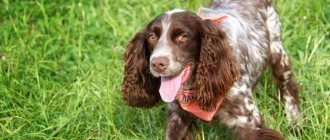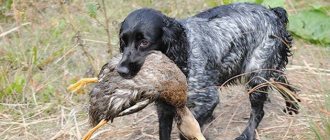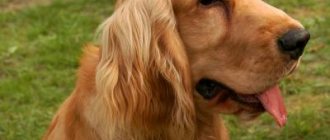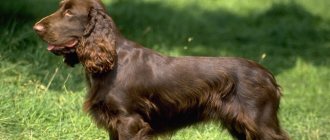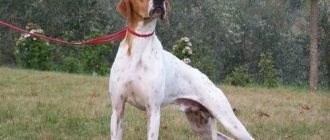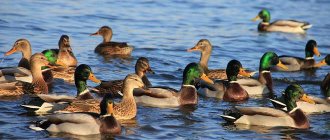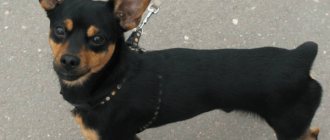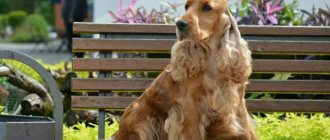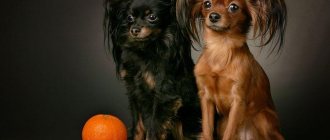Main characteristics
| Breed parameters | |
| Country of origin: | Russia |
| Weight of the breed: | males: 13-16 kg, females: 9-14 kg |
| Height at withers: | males: 38-45 cm, females: 36-42 cm |
| Temperament: | active |
| Wool: | long |
| Role in human life: | companion, hunting |
The Russian Spaniel is a dog that will always be nearby during the hunt and just for a walk. They are extremely intelligent, loyal and keenly aware of the mood in the family. They will always stand up for their owner and be there in difficult times.
Origin story
The appearance of Russian hunters is directly connected with the royal family of the Romanovs. Nikolai Romanov, the uncle of the last Russian Tsar, being an avid hunter, quite often brought animals of different breeds from his trips. It was in this way that the first individuals appeared in Russia, which were good hunters, however, not particularly suitable for the harsh conditions of Russia.
One of the first ancestors of modern spaniels is the English cocker spaniel named Dash. He belonged to the Grand Duke and became the father of several generations of puppies, which instantly dispersed among the famous nobles of the royal court.
Romanov set the fashion for these unusual animals. Domestic dog breeders quickly became fascinated by Russian hunters and fully appreciated their abilities. Imported cockers and springers proved excellent in working with all types of birds and performed well in pheasant hunting, which was preferred by representatives of the royal family. Thus, breeding spaniels has become not only fashionable, but also profitable.
At the beginning, the breeders were imported exclusively from abroad, a little later they began to haphazardly breed with each other, the species were crossed, no culling was carried out, and as a result, the same spaniel was born, which today is called “Russian”.
The first animals were without pedigrees and looked little like modern ones. They did not have the working qualities that these animals are endowed with today. By the beginning of the 20th century, individuals born in Russia were exported at exhibitions as a separate group. During the same period, the “stratification” of the unofficial breed into Moscow and St. Petersburg types began. The animals differed not only in appearance, but also in the type of work. By crossing these two species, the first specimen, more or less similar to the modern one, appeared.
Somewhat later, Leningrad breeders began improving the breed. They used both domestic material and imported animals for mating. Unfortunately, numerous achievements of those years were completely destroyed by the Second World War. After its completion, the breed was restored from practically nothing. The restoration task was complicated by the large number of mestizos and the lack of high-quality breeding material.
In 1951, the phenotype of animals was first fixed and the first standard was published. Since 1972, a ban on crossing different species of this group was introduced, which was the last step towards the final formation of a separate breed.
a brief description of
The Russian Hunting Spaniel is a hunting breed of dog developed by crossing several types of spaniels. The English Cocker, Springer, and Sussex had very long hair and short stature, so they could not give their full effort in hunting. In this regard, Russian breeders decided to develop a completely new breed, completely devoid of these shortcomings, but including the main advantages of spaniels.
The Russian spaniel is a fairly strong animal, with straight, even limbs. They have developed muscles, a strong physique, a tucked stomach, and long and thick hair. Height at withers up to 45 cm, weight approximately 18 kg. The tail is docked in half. Life expectancy is up to 20 years.
Acceptable color options: red, brown, black, black and piebald, red and piebald, brown and piebald, spotted white, black and tan, brown and tan. Eye color - honey.
The main advantage of the breed is its versatility. These dogs are ideal hunting helpers and loyal friends at home. The Russian pet helps the hunter track down the prey and bring it back. As a rule, they are used for hunting small fur-bearing animals, waterfowl and wild birds.
Russian hunters are very active and mobile, therefore they require special attention while growing up. The owner will have to try very hard during education and training. These animals are ideal for families with a large number of children, as they are friendly and easy-going.
Since the breed was created specifically for hunting, the benefits of active recreation with them are obvious. They are convenient to transport and feel great in any type of transport.
Interesting facts about the Russian hunting spaniel:
- When creating the breed, varieties of spaniels and pointers were crossed;
- There should be no strong odors in the house where spaniels live - they can interfere with a hunting dog’s sense of smell;
- The fur of this breed is practically odorless;
- This breed has not yet received official recognition from the International Canine Federation, only from the RKF.
photo: Russian hunting spaniel puppy (photo author: Valeria)
Character and temperament
The persistent and tireless worker is completely transformed at home. The pet becomes affectionate, attentive and good-natured. Moreover, you can always have a heart-to-heart talk with this dog; he will always listen to his owner and, if necessary, grieve with him. In everyday life, the Russian spaniel is unpretentious; he doesn’t care where he lives, as long as his owner is nearby. It is enough for him to have his own corner, a bowl of food and water.
In puppyhood, these are playful, very active babies. As you grow older, your temperament does not change at all. Even in old age, they retain their puppy activity and keen interest in entertainment. Such natural gifts allow them to quickly find a common language with children of any age; they do not conflict even with very young children, generously forgiving them for their pranks.
The spaniel's favorite game is fetch; they are ready to carry a ball, stick or frisbee for days. Don’t be lazy to play with your pet, devoting at least 10-15 minutes a day to him, you will win his boundless love. If you don’t have time for this, don’t worry, the dog will find something to do on its own.
The only drawback that the owner should pay attention to is the tendency to chew on various kinds of things. Spaniels love to chew leather goods; they remind them of game.
Animals have very developed intuition; they easily detect any mood changes in the family and try to resolve the situation, diverting all attention to themselves. They understand their person at a glance and know how to distinguish strangers into good and bad. If your pet growls with enviable consistency at someone you know, then you should think about the purity of this person’s intentions towards you.
Temperament and character
Positive aspects of character:
- friendliness;
- learning ability;
- playfulness;
- unobtrusiveness;
- self-sufficiency.
Negative features:
- touchiness;
- jealousy.
Increased excitability outside of puppyhood, cowardice and aggressiveness towards humans are considered disqualifying faults according to the breed standard.
Education and training
Spaniels learn very easily and literally grasp everything on the fly. They are not prone to whims, they have a good memory. However, you should not be too zealous in training, because these animals, like all representatives of the canine world, need praise and encouragement.
In order to raise a real hunter and tracker, it is important to focus on basic commands and not be scattered in different directions. For a spaniel to work properly, it is enough to know five basic commands.
Education should begin from the puppy's first steps in the house. The first thing you need to pay attention to is the identification of the owner. In the future, this person will become the center of the universe. If an animal is acquired as a hunting assistant, then no one should interfere with the training process except the owner. This must be a single tandem.
The name for the future hunter should be short and sonorous, however, it should not be in tune with the commands. You need to get used to it from the first days of moving. Only after mastering the nickname can you move on to the next stage - learning commands.
To complete hunting training, it is important to master the “give” command. As practice shows, Russian hunters master it quite quickly, however, bringing a stick is one thing, but bringing a shot bird is completely different.
You need to train your pet on the ground after 5 months. It is strictly not recommended to do this before. It is best to start training outdoors in the summer, when the ponds are already warmed up and the dog can safely rush into them.
Professional hunters most often acquire partners to work in the forest after the puppy has grown up. This way, you don’t have to raise and socialize your pet yourself. Of course, training an adult to suit you is much more difficult than training a small one to suit you, but it is safer.
As the year approaches, you will see what the dog has become and what it is capable of, that is, there will be no surprises.
Care and maintenance
Russian spaniels are quite active animals, however, they do not require maximum attention. You need to walk with them two to three times a day, preferably actively. For example, you can throw a ball or give the animal the opportunity to run around in the park. If the dog was purchased as a pet, then it can be slightly pampered, if as a hunting assistant, then it is important to adhere to a certain routine. After a walk, your pet needs to be thoroughly cleaned with a special brush, and also pay attention to its paws.
Immediately after a small puppy appears in the house, he needs to be shown his place. There should be no drafts, the temperature should be comfortable. Ideally, the room will be further away from the door so that the dog is not disturbed by extraneous smells and sounds. The sleeping place must be equipped with a sunbed, which must be constantly monitored. Your pet should have two separate bowls: for food and water. Adult dogs are fed twice a day (puppies more often), preferably at the same time.
Maintenance and care
When kept in an apartment, the Russian Hunting Spaniel requires regular walks. On normal days you need to walk for at least 30 minutes , on weekends – several hours .
Provide your dog with a permanent place, away from drafts and high humidity. However, it is better to organize the space in such a way that he lives in cool conditions . Overheating provokes colds and decreased immunity. The spaniel needs to be tempered!
There should be no strong odors in the house where the spaniel lives - this can irreversibly spoil the sense of smell.
It is necessary to regularly inspect and clean your dog's ears . This breed is prone to otitis media, so it is important to remove dirt in a timely manner and prevent inflammatory processes.
The dog needs frequent combing and cleaning of its coat (1-2 times a week). During the working season, you need to comb after each hunt. Once a quarter, it is recommended to wash the wool with special dog shampoos.
This breed does not need a haircut. If necessary, only the hair near the ears and around the anus is trimmed.
Teeth should be brushed regularly with a special toothpaste for dogs.
Health
In general, the breed is distinguished by good health and fairly strong immunity. However, like any other animal, they are susceptible to a number of diseases. The most common disease they suffer from is leptospirosis. This is due to the fact that the dog often dives into bodies of water that are not entirely clean and may contract an infection in the process. Also in such situations, animals quite often contract dermatomycosis, toxoplasmosis and various types of parasitic infections.
Droopy ears can also cause a lot of trouble for your pet. This kind of design is simply ideal for the development of otitis media. Frequently bathed animals are especially susceptible to it.
In addition to the above problems, the breed has a tendency to obesity and food allergies. Therefore, the choice of nutrition must be approached very responsibly.
